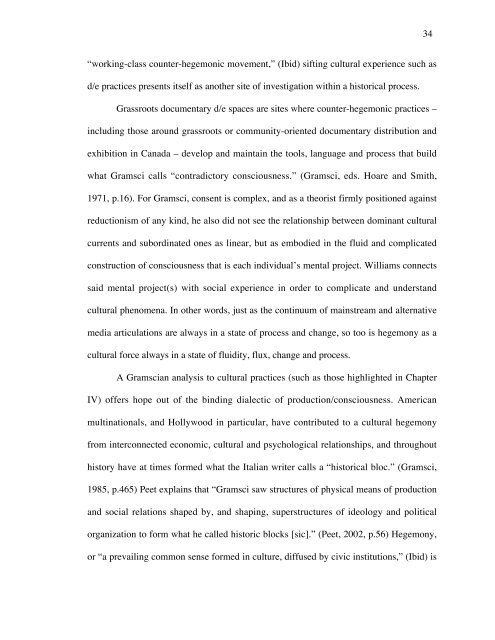The Spaces Between Grassroots Documentary ... - Ezra Winton
The Spaces Between Grassroots Documentary ... - Ezra Winton
The Spaces Between Grassroots Documentary ... - Ezra Winton
You also want an ePaper? Increase the reach of your titles
YUMPU automatically turns print PDFs into web optimized ePapers that Google loves.
“working-class counter-hegemonic movement,” (Ibid) sifting cultural experience such as<br />
d/e practices presents itself as another site of investigation within a historical process.<br />
<strong>Grassroots</strong> documentary d/e spaces are sites where counter-hegemonic practices –<br />
including those around grassroots or community-oriented documentary distribution and<br />
exhibition in Canada – develop and maintain the tools, language and process that build<br />
what Gramsci calls “contradictory consciousness.” (Gramsci, eds. Hoare and Smith,<br />
1971, p.16). For Gramsci, consent is complex, and as a theorist firmly positioned against<br />
reductionism of any kind, he also did not see the relationship between dominant cultural<br />
currents and subordinated ones as linear, but as embodied in the fluid and complicated<br />
construction of consciousness that is each individual’s mental project. Williams connects<br />
said mental project(s) with social experience in order to complicate and understand<br />
cultural phenomena. In other words, just as the continuum of mainstream and alternative<br />
media articulations are always in a state of process and change, so too is hegemony as a<br />
cultural force always in a state of fluidity, flux, change and process.<br />
A Gramscian analysis to cultural practices (such as those highlighted in Chapter<br />
IV) offers hope out of the binding dialectic of production/consciousness. American<br />
multinationals, and Hollywood in particular, have contributed to a cultural hegemony<br />
from interconnected economic, cultural and psychological relationships, and throughout<br />
history have at times formed what the Italian writer calls a “historical bloc.” (Gramsci,<br />
1985, p.465) Peet explains that “Gramsci saw structures of physical means of production<br />
and social relations shaped by, and shaping, superstructures of ideology and political<br />
organization to form what he called historic blocks [sic].” (Peet, 2002, p.56) Hegemony,<br />
or “a prevailing common sense formed in culture, diffused by civic institutions,” (Ibid) is<br />
34


